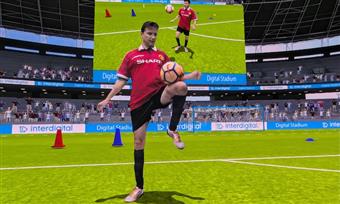 You can touch this: Haptics becoming central to the virtual live experience By Adrian Pennington
You can touch this: Haptics becoming central to the virtual live experience By Adrian Pennington Friday, October 24, 2025 - 09:12
Print This Story
The video industry in general, and sports in particular, is going multi-modal. The picture and audio alone are no longer enough as the industry has pushed resolution, dynamic range and audio fidelity to the point where enhancements are no longer monetisable. For this reason, attention is turning to new technologies which promise greater immersion in the game.
2D video is good. Everyone knows that, but if we want to add value to the experience we might want to bring additional media and we also want to bring interactivity, says Gaelle Martin-Cocher, senior director, media systems, InterDigital. The passive experience is good but younger generations demand more.
InterDigital, the US-headquartered research lab, develops the technologies that underpin many of today's video compression and wireless communications standards. A key focus now is how the sensations of touch, force, motion and temperature can enrich immersive experiences.
The goal is to enable interoperable transmission and rendering of tactile sensations across devices and platforms, complementing visual and auditory media, says Philippe Guillotel, senior director, at InterDigital and a leader of the group in MPEG that is standardising representations of haptic data.
SVG Europe was given a tour of the company's European HQ in Rennes, France, during which its experts served a number of demos. One potential use of haptic signals is to leverage data from pressure sensors in the balls used during the FIFA World Cup 2026 to send vibrations to mobile devices each time someone kicks it or when a goal is scored.
It's a very interesting use case and the data would be straightforward to collect, Guillotel says. I hope they will use it.
2D video is good. Everyone knows that, but if we want to add value to the experience we might want to bring additional media and we also want to bring interactivity
Another scenario is for Formula 1. Guillotel explains: There are already sensors detecting motion, acceleration, deceleration in the cars and you can use this information to enhance the feeling taking a chicane or a overtaking. In basketball, when someone barges into you, you could receive that feedback.
The easiest way to do it would be to have a library of effects ready to go and to have someone push a button for the appropriate effect when an event like a foul or a goal happens during the live broadcast.
It would also be possible to automate this process using computer vision. Sensory experiences could potentially be conjured from anywhere in the stadium or on the pitch such as inside a rugby scrum or next to a high diver 10 metres above the pool.
Haptics standards
In October 2021, MPEG officially recognised haptics as a core media type, placing it on equal footing with audio and video. Finally published in January 2025 as ISO/IEC 23090-31, the new MPEG-I Haptics coding standard unifies the encoding of vibrotactile and kinesthetic data, enabling interoperable, high-fidelity tactile feedback across XR, gaming, and broadcast.
This paves the way for haptics to be encoded, streamed, and rendered within the same ecosystem that powers today's media experiences - from mobile devices to cinema and XR headsets.
We have developed standards to describe the haptic information and distribute it using traditional broadcast or streaming formats including Dash, MP4 file format and CMAF. Establishing a consistent approach to the delivery of haptics is important to the technology's adoption across immersive entertainment.
Any device implementing the standard interface gloves, vests, gamepads, or robotics actuators can decode or adapt tactile data using the metadata-driven mapping layer.
The architecture supports very low bitrate (about 8kbps) synthetic effects meaning that a haptic track is a very light weight addition to the payload. MPEG is now extending the framework to cover interactive haptics, avatars and object-based touch interactions, forming the next phase of the Haptics standard for advanced XR applications.
A key question is whether sports fans want this.
Guillotel says that feedback from tests has been positive but that it's difficult to judge when the technology is so new. I'm convinced that it will be something people will use but it's too early to know. The issue is the device. One of the reasons we are concentrating on delivering haptics to smartphones, game controllers and especially to the headset is that most people have these and are comfortable with them. We need devices to be inexpensive to be adopted by the market.
Further demos on show at InterDigital included real-time delivery of volumetric video combined with haptics. The video would be captured from a multi-cam array surrounding the athlete and presented against a CG environment such as a sports stadium. Viewable in 2D displays or VR headsets, the application is considered useful for training by coaches and athletes able to playback, pause and interact with the 3D video.
Being present
Haptics are part of a wider concept emerging in media which aims to immerse viewers in the sensation of being present.
Val rie Alli , senior director for media services, InterDigital, says: Imagine the year is 2032 and you are preparing to watch your country's athletes compete at the Brisbane Olympics. Maybe you personalise your perspective to replay a winning goal or use AR overlays to cross the finish line with your favourite athletes. This potential to deliver high-quality, immersive content, whether through avatar interactions that will enrich the in-stadium experiences, or live 3D immersive content, and the ability to sense this experience thanks to haptic feedbacks, al































































